Back pain is one of the most common complaints among people over the age of 25-30. These can occur not only as a result of overload, but can also act as a symptom of diseases of the spine or internal organs. Therefore, it is important that you pay attention to your health and do not ignore the problem. After all, if back pain is provoked by the appearance of pathological changes in the spine, they can eventually lead to serious complications and even disability.
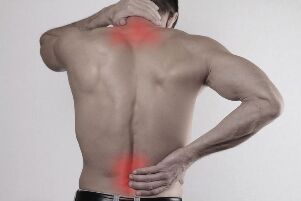
Causes
In many situations, your back hurts for natural reasons: exhausting physical work, hard training, walking in long-heeled high heels, and so on. In such situations, the pain is caused by the formation of lactic acid in the muscles, and especially in severe cases and micro-tear muscles, sprains. Therefore, in order to eliminate them, the backrest must be provided for several days.
Pregnancy is a common cause of back pain. Because the body undergoes a lot of changes, especially in late pregnancy, it can respond to pain in the lower back. If these are not acute and do not result in lower abdominal discomfort or the appearance of unusual secretions, this is considered a normal version. But at the same time, ongoing changes, a shift in center of gravity, and an increase in a woman’s weight during pregnancy can trigger the exacerbation of chronic diseases or the development of degenerative-dystrophic changes in the spine.
Due to the fact that the load on a woman's body doubles during pregnancy, it is very important to put the spine in order. Our clinic has developed and prepared a special program of comprehensive examination and treatment for pregnant women and pregnancy planners.
Degenerative-dystrophic processes, as well as other spinal pathologies, are the most common cause of back pain in women and men over 30 years of age. With these, the pain can be localized on any part of the back (neck, between the shoulder blades, in the lower back) and the head, shoulders, arms, buttocks, legs, etc. , be present continuously or occur after physical exertion. All of these are important signs that help determine the cause of pain syndrome and therefore find an effective way to eliminate it.
The most common diseases associated with back pain are:
- osteochondrosis, protrusions and intervertebral hernias; curvature of the spine
- (kyphosis, scoliosis, lordosis, and combinations thereof);
- myofascial syndrome.
Slightly less often, back pain is caused by compression fractures of the spine (typical of the elderly or people who have suffered injuries, fall from a height, have an accident), ankylosing spondylitis, spondylosis, spondylolisthesis, and other
Pain in different parts of the back can also be caused by abnormalities in the work of internal organs. For example, neck pain may be accompanied by pathologies of the thyroid gland, inflammation of the lymph nodes, diseases of the blood vessels, and pain in the lower back to pathology of the kidneys, pelvic organs, and gastrointestinal tract. Unpleasant feeling in the middle of the back, in the area of the shoulder blades, is quite rare, but it also occurs. In addition to spinal diseases, the occurrence of abnormalities in the work of the heart, etc. Rejlik
The crux of the problem, however, is that diseases of the internal organs do not stem from blue. Almost always, a violation results in segmental innervation, that is, the quality of the transmission of nerve impulses from the spinal cord to organs delivered through nerve roots and branches. Each level of the spinal cord has its own pair of spinal roots from which the nerves branch and reach the appropriate organs. If changes occur in the spine, such as curvatures, displacement of the vertebrae, changes in the height and condition of the intervertebral discs, this inevitably affects the condition of the spinal roots and spinal cord. Different vertebral structures can constrict or even be damaged as they change their natural parameters and position. Therefore, nerve impulses are transmitted to the organs worse, leading to the appearance of initially insignificant but continuously progressive disorders. Gradually, organic changes appear in the organs that cause the disease to develop. Therefore, in the case of back pain and detection of pathologies of the internal organs, it is imperative to examine the spine and find the changes that triggered their development. The effect on them increases the effectiveness of the treatment of internal diseases and, most importantly, eliminates the preconditions for their occurrence.
Each spinal motion segment has its own pair of nerve roots that transmit signals to a specific organ.
Osteochondrosis, protrusion and intervertebral hernia
Osteochondrosis is the most common disease of the spine, present in every second adult at different stages of development. Degenerative-dystrophic changes are accompanied by intervertebral discs, i. e. , their gradual destruction.
Depending on which part of the back pain occurs and, accordingly, the degenerative-dystrophic processes in the intervertebral discs, we distinguish between osteochondrosis of the neck, chest, and lumbar spine. Most often, the plates of the lumbosacral spine are destroyed, somewhat less frequently - in the cervix, and rarely diagnosed with osteochondrosis of the thoracic spine.
In osteochondrosis, the pain is typical, initially weak, after physical exertion or prolonged sitting. They gradually increase and become more frequent. Over time, the discs become so exhausted that their outer shell cannot withstand the loads placed on it and deform, i. e. , a protrusion is formed, which eventually transforms into a fracture. In the latter case, the annular fibrosis is completely ruptured and the internal contents of the disc are able to fall out into the spinal canal.
In both cases, the protruding parts can compress the roots of the spine, thereby provoking the occurrence of radical syndrome. This means that in addition to the pains being sharp and severe, they also get their arms, legs, buttocks and other body parts, which depends directly on which disc is deformed. So when the nerves in the cervical spine are constricted, the pain is usually on the shoulders and arms, and when the nerves in the lumbar spine are compressed, on the buttocks and legs. This is often accompanied by sensory disturbances, including numbness, creeping sensations, and gradual muscle atrophy.
The disease involves irreversible changes in nerve fibers that can lead to paralysis and disability.
Curvature of the spine
Curvature of the spine can be observed anywhere. A perfectly straight spine is a rarity today, so more or less pronounced deformities are present in almost every person today. This could be:
- kyphosis - strengthening the natural curvature of the spine in the cervicothoracic region;
- lordosis - increased natural deflection of the spine in the lumbar spine;
- scoliosis - a lateral deformity of the spine.
Curvature can always lead to compression of different groups of nerves, which also triggers radical syndrome. But if the changes in the early stages of development in osteochondrosis are visually impossible to overcome, spinal deformities can be easily diagnosed by asymmetry in the position of the shoulder blades, pelvic bones, protrusion of the abdomen, or the formation of a hump.

Myofascial syndrome Myofascial syndrome is not a dangerous but rather a painful condition in which certain muscle groups become spasmodic under pressure or physical activity. Therefore, if you press the place where back pain usually occurs in the background of absolute normal health, you may get a new acute pain attack, which is an important diagnostic criterion.
Diagnose the causes of back pain
If you experience back pain, whether in the neck, between the shoulder blades, or in the lumbar region, it is recommended that you consult a neurologist. If pain is irradiated to other parts of the body, a chiropractor, vertebrologist, and neurologist should be consulted as soon as possible, as this is a sign of radical syndrome.
Our specialists use an integrated approach to diagnosis and treatment so they can quickly make the right diagnosis. Diagnosis begins with an assessment of the patient, during which the nature of the complaints presented and the characteristics of work and rest are clarified. The physician should carefully examine the patient by palpation of the spine and perform special functional and neurological examinations. This allows you to form a comprehensive picture of the patient’s condition, detect signs of neurological deficiency, and assess the extent of the damage. In order to clarify the diagnosis, it is mandatory to appoint:
- X-ray examination;
- CT;
- MRI.
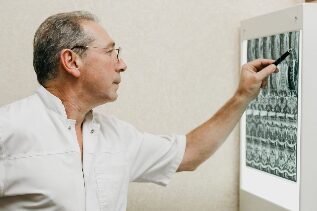
In the absence of contraindications, MRI is always preferred, as this method can provide the most complete data on the condition of the spine and especially its discs, allowing the diagnosis of minor changes in their condition at the earliest stages and timely intervention. pathological process.
In our clinic, you can learn more about the composition of your body and the condition of the vascular system, which is involved in the blood supply to the internal organs, musculoskeletal muscles and brain. Our experienced doctors will explain the findings to you in detail. Bioimpedanometry calculates the ratio of fat, muscle, bone and skeletal mass, total body fluid, metabolism. The intensity of recommended physical activity depends on the state of muscle mass. And metabolic processes affect the body's ability to heal. Indicators of active cell mass can be used to assess levels of physical activity and nutritional balance. This quick and easy test will help you see endocrine disorders and take action. In addition, it is very important for us to know the condition of blood vessels in preventing diseases such as heart attack, high blood pressure, heart failure, diabetes and much more. Angioscan makes it possible to determine important indicators such as the biological age, stiffness, stress index (which speaks of heart rate), and oxygen saturation of the blood vessels. Such screening can be useful for men and women over the age of 30, athletes, people under long and difficult treatment, and anyone who monitors their health.
If the diagnosis shows that the back pain is the result of the development of diseases of the internal organs, the patient is referred to narrow specialists such as urologist, endocrinologist, gynecologist, gastroenterologist, cardiologist, etc.
Body composition analysis provides information about how much adipose tissue and locomotor components are in the body. These data help the rehabilitator to prepare a physical activity plan correctly, taking into account the individual characteristics of the patient.
Treating Back Pain
Treating back pain is always complex, as pathological changes in the spine cannot be eliminated with medication alone. In addition, for each patient, the therapeutic regimen is strictly tailored to the individual. Not only the diagnosis and stage of development of the disease are taken into account, but also the presence of concomitant diseases, the age, habits and work characteristics of the patient, the level of physical fitness and other factors. Therefore, treatment may be different for patients with the same diagnosis. Only this approach gives maximum results.
So the main elements of conservative therapy for vertebrogenic back pain are:
- drug therapy;
- osteopathy;
- manual therapy;
- massage;
- physiotherapy (phonophoresis, carboxytherapy, ozone therapy, pressotherapy RF currents);
- individual lesson with a rehabilitation doctor.
Patients are strongly advised to reduce their weight as much as possible and to avoid excessive physical activity and a sedentary lifestyle. A balanced diet further enhances the effect of treatment.
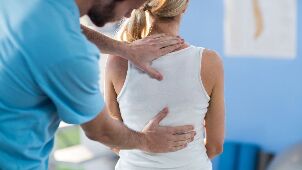
Drug Therapy
Depending on the combination of different factors, medication may include drugs from different pharmacological groups. In the vast majority of cases, patients are prescribed:
- NSAIDs;
- corticosteroids;
- muscle relaxants;
- chondroprotectors;
- B vitamins;
- Vitamin D
Patients with very severe radical pain who cannot be treated with non-steroidal anti-inflammatory drugs or analgesics may be offered blockages. The method involves introducing a solution of lidocaine or novocaine, sometimes in combination with corticosteroids, directly into the area of transit of the compressed nerve. They have no therapeutic effect, but they even allow for the rapid elimination of severe neurological pain. But the implementation of blockades requires special skills and absolute sterility, as such injections can lead to serious complications.
Manual therapy
Manual therapy is rightly considered to be one of the main components of the treatment of back pain of various origins, as it allows the normal anatomy of the spine to be restored and at the same time:
- to improve the quality of transmission of nerve impulses along all peripheral nerves to all organs of the human body;
- activates blood circulation and lymph flow;
- initiates the natural processes of body recovery and creates favorable conditions for their flow;
- strengthens immunity and increases the body's ability to adapt to new living conditions, etc.
The use of special techniques of manual action directly on the spine and surrounding tissues makes it possible to eliminate pressure from various anatomical structures at the roots of the spine, leading to the elimination of pain, including pain radiating to the limbs and other parts of the body. In addition, they can increase the distance between vertebral bodies, which provides the most favorable conditions for the restoration of deformed vertebral discs, and active kneading of muscles helps to remove functional blocks, increase spinal mobility and flexibility, and speed up metabolic processes.
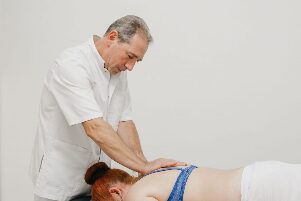
We do not have common treatment standards, we take a unique approach to each patient. Gritsenko’s authoring technique has shown great efficiency over the years. It has a special effect on the spine, as a result of which not only the back pain disappears, but also the causes of their occurrence are eliminated. And normalizing the segmental innervation of the spinal cord helps to improve the functioning of the internal organs and eliminate the causes of the progression of their diseases.
Thus, patients with back pain can expect distinctly positive changes after 1-2 manual therapies using the author’s Gritsenko method. How many procedures will be required to achieve the greatest possible result, and its consolidation will be chosen individually for each patient.
Physiotherapy
Physiotherapy is prescribed outside the acute period of the disease. It can be used to increase the effect of other methods of influence. As a general rule, patients should be prescribed treatments that have anti-inflammatory, analgesic, antispasmodic properties, namely:
- electrophoresis;
- traction therapy (spinal cord traction);
- UHF;
- laser therapy;
- ultrasound therapy etc.
gym therapy
Physiotherapy is not the last ingredient in treating back pain. The stability of the result is highly dependent on the regularity and correctness of its implementation, as exercise therapy is primarily aimed at strengthening the back muscle ligament, which will provide support to the spine and reduce the load on the intervertebral discs. In addition, exercise helps to improve the quality of blood circulation, resulting in a more active supply of drugs and nutrients for the lesions, which increases the effectiveness of the therapy.
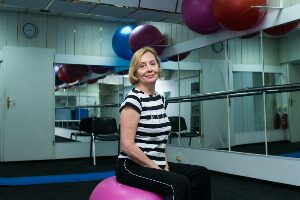
But it is not recommended to choose a series of exercises yourself, as performing the generally recommended exercises can harm the patient due to overloading certain muscle groups. Therefore, the creation of the optimal complex should be entrusted to a doctor - a rehabilitologist who will teach a person to perform each exercise correctly.
Although back pain is familiar to all adults, it is not worth considering them as harmless. Such negligence can result in serious complications and can be treated surgically at best. In the worst case, the patient is disabled. Therefore, if your back pain occurs with an enviable regularity, or is rather acute, check with a neurologist and find out the real cause of the discomfort. After all, the disease is much easier to stop at an early stage of development.

























